Intel Core i7 4960X (Ivy Bridge E) Review
by Anand Lal Shimpi on September 3, 2013 4:10 AM EST- Posted in
- CPUs
- Intel
- Ivy Bridge
- Ivy Bridge-E
Memory Performance
Seeing as how the huge L3 cache and quad-channel memory interface are big parts of what makes Ivy Bridge E unique, I thought it might make sense to look at memory latency and bandwidth. We'll start with memory latency, compared to Ivy Bridge, Haswell and Haswell + Crystalwell.
The larger L3 cache buys IVB-E lower latency accesses for a wider range of addresses, but once you exceed the 15MB L3 cache space we see latency about on par with everything else. Only Haswell + Crystalwell manages to hold out for longer. Unfortunately that's not really a part desktop enthusiasts can buy so it's mostly an academic comparison.
The bandwidth story is an interesting one. Sandra maxes out bandwidth by driving all cores at the same time, so you get some uplift here by there simply being more cores under IVB-E's hood. But even if you divide out the number of cores, you get per core cache bandwidth figures that are extremely high (at least outside of L1). The L3 cache in particular is quite bandwidth happy.
Going outside of the L3 cache, we also see a doubling of memory bandwidth - which is expected given the doubling of memory interface width. In reality the peak memory bandwidth advantage would be even larger as IVB-E officially supports DDR3-1866 (if you only populate 1 DIMM per channel, otherwise either 1333 or 1600 is officially supported).
General Performance
I don't know that I've ever seen an Intel slide before that called out a performance degradation, but there's a first time for everything:
The problem with IVB-E vs. Haswell is that the extra large L3 cache and quad-channel memory interface are generally only useful in heavily threaded applications, which of course benefit from its 6-core configuration. In those tests that aren't heavily threaded however, IVB-E typically sees a single threaded performance deficit compared to Haswell. Given that the 4960X and Haswell based Core i7-4770K run at very similar frequencies, it's not surprising to see IVB-E take a backseat to Haswell in in "everyday computing" tasks. Intel's slide above claims about a 18% reduction in "everyday computing" performance compared to the 4770K, but in practice I found the gap to be much narrower.
Although not the best indication of overall system performance, the SYSMark 2012 suite does give us a good idea of lighter workloads than we're used to testing.
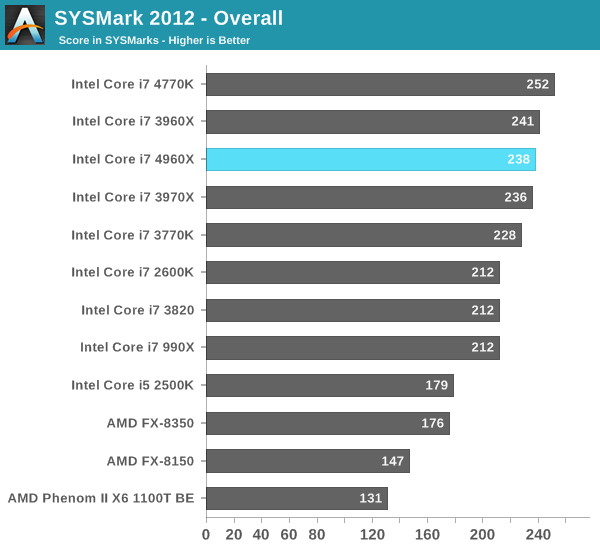
There's pretty much no advantage to the 4960X over the 3970X here. Remember Ivy Bridge's architectural improvements were very limited on the CPU side. As clock speeds didn't really go up between the 3970X and 4960X, the performance parity here isn't surprising. Haswell manages a ~6% performance advantage over the 4960X at an obviously lower power and price point.
Although I retired SYSMark 2007 a while ago, I do have much older performance data here which lets us compare the 4960X back as far as the early Pentium 4 based Extreme Edition parts:
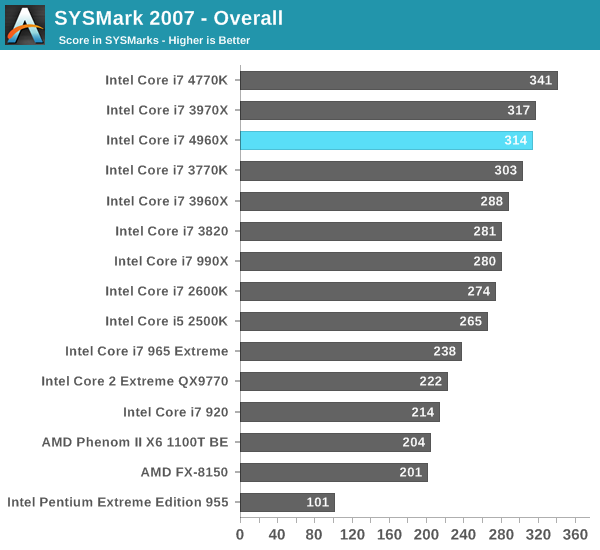
The Haswell advantage grows a bit here to around 8%, but the 4960X remains in the top three performers here. It's very clear that for most users, there are far more cost effective ways of getting great performance than IVB-E.
Our final lightly threaded test is Mozilla's Kraken JavaScript benchmark. This test includes some forward looking js code designed to showcase performance of future rich web applications on today's software and hardware. We run the test under IE10:
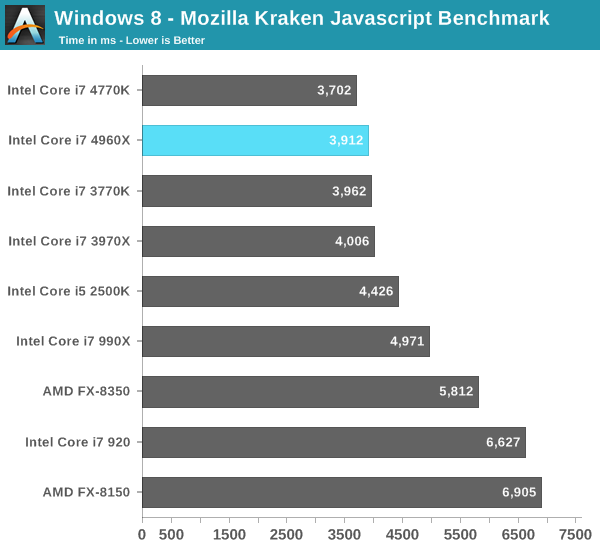
Ivy Bridge always had good single threaded performance, but once again these lightly threaded use cases are better served by an architecture with higher IPC. The Haswell advantage isn't huge, but it's a lower power/more cost effective way to get the best performance here.
If you are still on LGA-1366, you'll note that the performance gains here are good, but not earth shattering. Comparing to Intel's first 6-core platform, the 4960X manages a 27% increase in performance over the Core i7-990X. That's a healthy gain, but it's still small enough where there's no immediate need to upgrade.


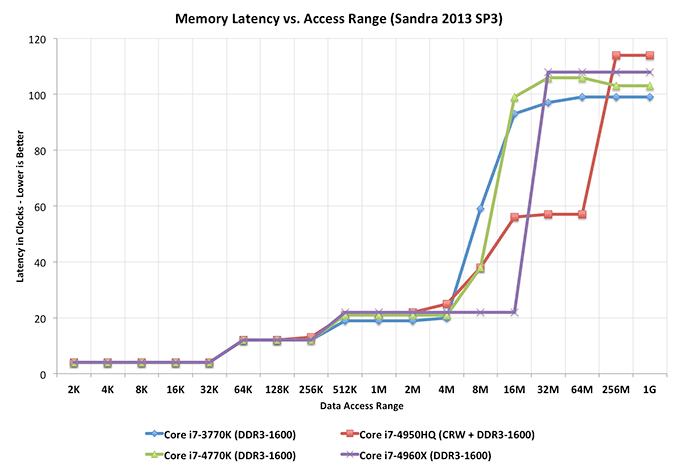
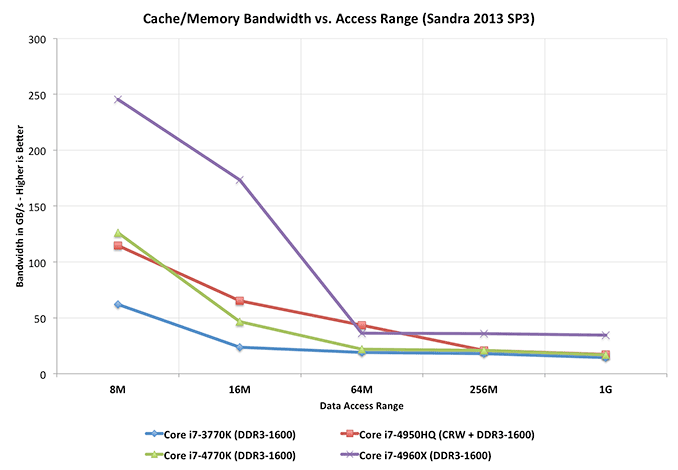
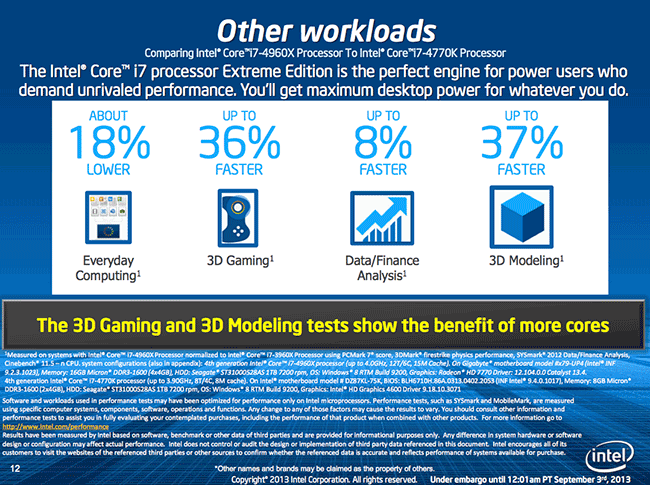








120 Comments
View All Comments
madmilk - Tuesday, September 3, 2013 - link
If you invested in the 980 or the 970 (not the extreme ones) you got an awesome deal. Three years old, $600, overclockable, and within 30% of the 4960X on practically everything.bobbozzo - Tuesday, September 3, 2013 - link
True, but my Haswell i5-4670k was around $200 for the CPU (on sale), and under $150 for an ASUS Z87-Plus motherboard.It's running on air cooling at 4.5/4.5/4.5/4.4GHz.
I wasn't expecting it to be as fast for gaming as an i7-4770k, but looking at the gaming benchmarks in this article, I'm extremely pleased that I did not spend more for the i7.
althaz - Tuesday, September 3, 2013 - link
I had a launch model Core 2 Duo (the E6300) that with overclocking (1.86Ghz => 2.77Ghz) was a pretty decent CPU until last year (when I replaced it with an Ivy Bridge Core i5). That's what? Six years out of the CPU and it's still going strong for my buddy (to whom it now belongs).Kevin G - Tuesday, September 3, 2013 - link
"My biggest complaint about IVB-E isn't that it's bad, it's just that it could be so much more. With a modern chipset, an affordable 6-core variant (and/or a high-end 8-core option) and at least using a current gen architecture, this ultra high-end enthusiast platform could be very compelling."I think that you answered why Intel isn't going this route earlier in the article. Consumers are getting the smaller 6 core Ivy Bridge-E chip. There is also a massive 12 core chip due soon for socket 2011 based servers. Harvesting an 8 core versions from the 12 core die is an expensive proposition and something Intel may not have the volumes for (they're not going to hinder 10 and 12 core capable dies to supply 8 core volumes to consumers). Still, if Intel wanted to, they could release an 8 core Sandy bridge-E chip and use that for their flag ship processor since the architectural differences between Sandy and Ivy Bridge are minor.
The chipset situation just sucks. Intel didn't even have to release a new chipset, they could have released an updated X79 (Z79 perhaps?) that fixed the initial bugs. For example, ship with SAS ports enabled and running at 6 Gbit speeds.
Sabresiberian - Tuesday, September 3, 2013 - link
"The big advantages that IVB-E brings to the table are a ridiculous number of PCIe lanes , a quad-channel memory interface and 2 more cores in its highest end configuration."I'm going to pick on you a little bit here Anand, because I think it is important that we convey an accurate image to Intel about what we as end-users want from the hardware they design. 40 PCIe 3.0 lanes is NOT "ridiculous". In fact, for my purposes I would call it "inadequate". Sure, "my purposes" are running 3 2560x1440 screens @ 120Hz and that isn't the average rig today, but I want to suggest it isn't far off what people are now asking for. We should be encouraging Intel to give us more PCIe connectivity, not implying we have too much already. :)
canthearu - Tuesday, September 3, 2013 - link
Actually, you would find that you are still badly limited by graphics power, rather than limited by system bandwidth.A modern graphics card doesn't even stress out 8 lanes PCIe 3.0.
I'm also not saying that it is a bad thing to have lots of I/O, It isn't. However you do need to know where your bottlenecks are. Otherwise you spend money trying to fix the wrong thing.
The Melon - Tuesday, September 3, 2013 - link
Not all high bandwidth PCI-e cards are graphics cards.I for one would like to be able to run 2x PCIe x16 GPU's and at least 1 each of LSI SAS 2008, dual port DDR or QDR Infiniband, dual port 10GBe and perhaps an actual RAID card.
Sure that is a somewhat extreme example. But you can only run one of the expansion cards plus 2 GPU before you run out of lanes. This is an enthusiast platform after all. Many of us are going to want to do Extreme things with it.
Flunk - Tuesday, September 3, 2013 - link
Now you're just being silly, sending $10,000 on a system without any real increase in performance for anything you're going to do on a desktop/workstation is just stupid.Besides, if you're being incredibly stupid you'd need to go quad Xeons anyway (160 PCI-E lanes FTW).
Azethoth - Tuesday, September 3, 2013 - link
On the one hand, good review. On the other hand, my dream of a new build in the "performance" line is snuffed out. It just seems so lame making all these compromises vs Haswell, and basically things will never get better because the platform target is shifting to mobile and so battery life is key and performance parts will just never be a focus again.f0d - Tuesday, September 3, 2013 - link
i feel the same waythe future doesnt look too bright for the performance enthusiast - i dont want low power smaller cpu's i want BIG 8/12 core cpus and i dont really give a crap about power usage